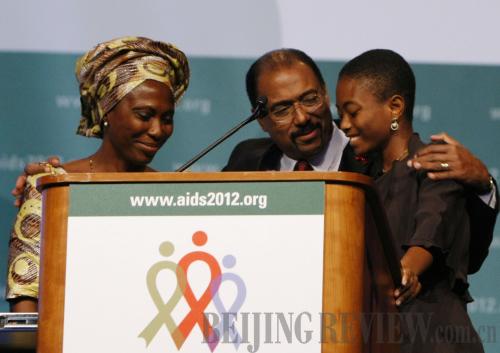|
 |
|
GLOBAL CARE: UNAIDS Executive Director Michel Sidibe (center) hugs an HIV-positive mother from Nigeria and her daughter at the opening session of the International AIDS Conference on July 27 in Washington, D.C. (FANG ZHE) |
The International AIDS Conference closed on July 27 in Washington, D.C. with a clear message that the end of the AIDS epidemic is possible with sustained financial, political and scientific commitment.
The event, under the theme of "turning the tide together," drew nearly 24,000 participants from 183 countries, featuring 194 sessions covering science, community and leadership.
"It is a historic event," said Dr. Diane Havlir of the University of California, San Francisco, who co-chaired the world's largest AIDS meeting. "It's, first of all, very significant that it is finally back here in the United States."
The first International AIDS Conference was held in Atlanta, Georgia in 1985, and it was last held in the United States in San Francisco in 1990. U.S. restrictions on the entry of people living with HIV prohibited the conference's return in the ensuing 20 years. In 2010, this ban was lifted by the Barack Obama administration.
Defining moment
Ahead of AIDS 2012, the Joint United Nations Programme on HIV/AIDS (UNAIDS), released a new report, titled Together We Will End AIDS, which outlined the recent gains made in achieving the global AIDS targets, including increases in HIV treatment coverage and domestic investments in low- and middle-income countries.
"It is now for a new AIDS agenda and new partnerships based on shared responsibility, mutual accountability and global solidarity," said Michel Sidibe, UNAIDS Executive Director at the opening session on July 22.
Much of the weeklong conference was focused on how to get treatment to all people with HIV, and looking to achieve an end to the virus' epidemic spread. Most of the presenters, from senior government officials and heads of health institutes to civil society leaders and scientists, affirmed for the first time in the history of AIDS that an end to the epidemic is on the horizon.
"I didn't have a lot of expectations when I came, but I now have to say the level (of the conference) is really high," Denis Broun, Executive Director of UNITAID, a Geneva-based international facility for the purchase of drugs against HIV/AIDS, malaria and tuberculosis, told Beijing Review, "I'm very happy to see a lot of positive news, a lot of new engagement and strategies at the conference."
With the recent scientific progress on the treatment and prevention of HIV infection, AIDS mortality rates are declining globally. And efforts to eliminate mother-to-child transmission are progressing well, according to Science magazine.
Over 8 million people worldwide had access to life-saving treatment in low- and middle-income countries last year—an increase of 1.4 million over 2010, according to the latest UNAIDS report. Some 34.2 million people are living with the AIDS virus globally, including 2.5 million who became infected last year. And 1.7 million died in 2011. New infections and deaths dropped slightly last year. Since 2009, new infections in children have fallen by an estimated 24 percent. Some 330,000 children were newly infected in 2011, almost half the number at the peak of the epidemic in 2003.
|
